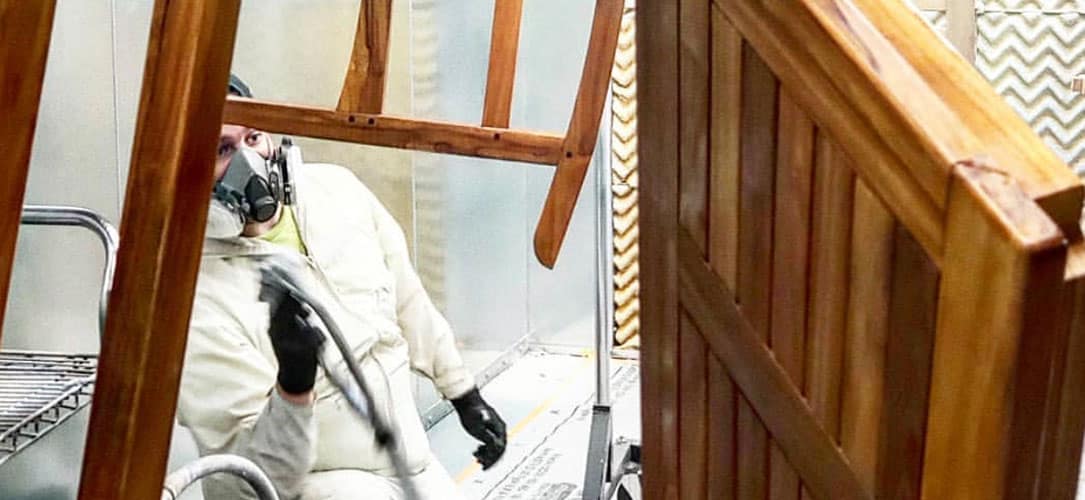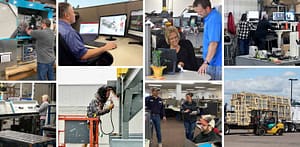
When choosing among woodworking paint booths, woodworkers have two primary options: an open face paint booth or an enclosed paint booth. The first option takes less floor space and is more cost-effective but lets in more contaminants, while the latter is larger and more expensive but produces a better quality finish.
Often, the spray booth decision is primarily driven by the importance of paint finish quality. The amount of space available in their facility and the cost of the equipment also play into a woodworker’s choice when selecting an open face or enclosed paint booth.
Controlling contamination in open face paint booths is difficult, especially in wider booths used in the manufacturing or refinishing of cabinets, furniture and doors. To reduce contamination, woodworkers try to keep pre-finishing operations — milling, assembling, prepping and sanding — away from their paint booth. Still, contaminants are inevitable in an open face paint booth, as unfiltered air is pulled into the spray booth by the exhaust fan.
“If you want to achieve high-quality paint finishes, you need to control contamination in the paint booth,” said Royce Day, industrial project manager for Global Finishing Solutions (GFS). “Open face paint booths inherently have issues with attracting whatever particles are in the area, often sanding dust.”
Open face paint booths are only available in cross draft airflow; however, enclosed paint booths are available in several airflow styles, including cross draft, side downdraft and downdraft. The style of airflow can have a significant impact on the quality of the paint finish.
With cross draft airflow, air enters at the front of the booth, then flows horizontally through the spray booth, over the product and into a filter bank at the rear of the spray booth. As one product is sprayed, overspray may be pulled across products downstream, affecting the quality of the paint job.
Side downdraft airflow provides a consistent flow from each end of the spray booth. This is due to a filtered ceiling and exhaust plenums that run along both sides of the spray booth. The air flows downward, over the product and toward floor-level plenums, keeping overspray away from the product being painted.
Similar to side downdraft spray booths, enclosed paint booths featuring downdraft airflow achieve uniform airflow through a full-length, filtered ceiling and exhaust pit. Gravity carries overspray into the exhaust pit, making downdraft airflow the best airflow style for controlling overspray and contamination.
The handling of parts in a woodworking paint booth can be cumbersome if the spray booth is not very wide. Open face paint booths are perhaps most attractive to woodworkers due to the flexibility in their dimensions. While traditional automotive and truck paint booths are typically deeper than they are wide, standard GFS Open Face Paint Booths range from 6 to 20 feet wide and can be purchased with depths of only 6 or 8 feet. This allows products like cabinets to be stacked inside and easily accessible to the painter for spraying.
GFS Enclosed Finishing Paint Booths feature the same structure as GFS Open Face Paint Booths, but have the added benefit of filtered product doors for contamination control. Woodworkers with Enclosed Finishing Paint Booths often choose smaller models due to the added cost of filtered doors.
“When you put a set of doors on a paint booth, it requires the floor space for the doors to swing open,” Day said. “A lot of woodworking shops have space limitations.”
Compared to automotive collision repair shops and industrial metal manufacturers, profit margins in woodworking businesses are typically smaller than other businesses. Low-production facilities do not produce as many or as large of products, which translates to smaller profit margins. This may make woodworking businesses more cautious and price-sensitive when investing in new equipment, such as a paint booth.
Open face spray booths are a more budget-friendly option than enclosed paint booths. Not only is the upfront cost lower, but they also require smaller and fewer fans, as well as fewer filters, since they do not feature intake filtration. Compared to equivalent-sized paint booths with cross draft airflow, enclosed paint booths with downdraft airflow are about 25 percent more expensive upfront, excluding pit installation costs of as much as $10,000. Pit grating is another large expense with downdraft paint booths, as are a plenum and a full ceiling of intake filters.
Ongoing operational costs are also higher for enclosed paint booths than open face spray booths. Downdraft enclosed paint booths require a significantly higher volume of air — about 20 to 40 percent more — compared to cross draft open face paint booths.
Woodworkers that want to reduce contamination but do not want to pay the added costs for an enclosed paint booth may consider placing curtains on an open face paint booth. Since fresh air is still needed for the booth, it must be pressurized with an intake fan or air make-up unit (AMU). Gaps will still exist around the curtain in which air could enter, meaning the booth must be maintained at a slightly negative pressure to ensure overspray and vapors are confined to the spray booth.
It is also not uncommon for woodworkers to spray in a dedicated room or in modified containers with an exhaust fan, or even to spray inside an enclosure of curtains. However, a paint booth is not only needed to meet national, state and local code requirements, it helps woodworkers protect their employees and avoid environmental issues.
Regardless of the type of woodworking paint booth you select, it is important to choose a reliable paint booth manufacturer that provides local support. Reputable manufacturers such as GFS have a vast, experienced distribution network to assist you any time you have maintenance issues or if you are in need of a rush order of filters. And when it comes time for growth planning, your woodworking business has someone it can trust.
One of the best ways to highlight your business is through a story that you can share across your online platforms. It humanizes your business and shows that your business can make a meaningful impact. Your testimonial would be used as a project profile on the GFS Booth Blog and can be shared on your website and/or social media channels.
Complete this form and we’ll be in touch to showcase your company.

Shop a variety of GFS aftermarket products, including booth protection products and mobile accelerated curing units. And enjoy the convenience of fast and free ground shipping throughout the contiguous United States.

Located at GFS’ headquarters in Osseo, Wisconsin, the Center for Excellence is an innovative facility featuring an automotive refinish training center, as well as a separate space dedicated to technical product training.

GFS is continuously searching for talented, ambitious individuals to join our team. We aim to provide our employees with every opportunity to make an impact on the company and find their niche along the way — weather in a production, field services or an office position.